An artist statement is a short description of an artist’s work that outlines the creative process, inspiration, objective, and methods or techniques used to create a piece of art or usually used by an artist. As a result, an artist statement can be made for each work or an artist’s entire body of art.
When making an artist statement, you should use your own words to describe what you create and why you create it. The artists should use a few sentences to introduce the artwork and engage with the art enthusiast or viewer. Artist statements are used to enhance the experience of interacting with art.
Artist Statement Examples
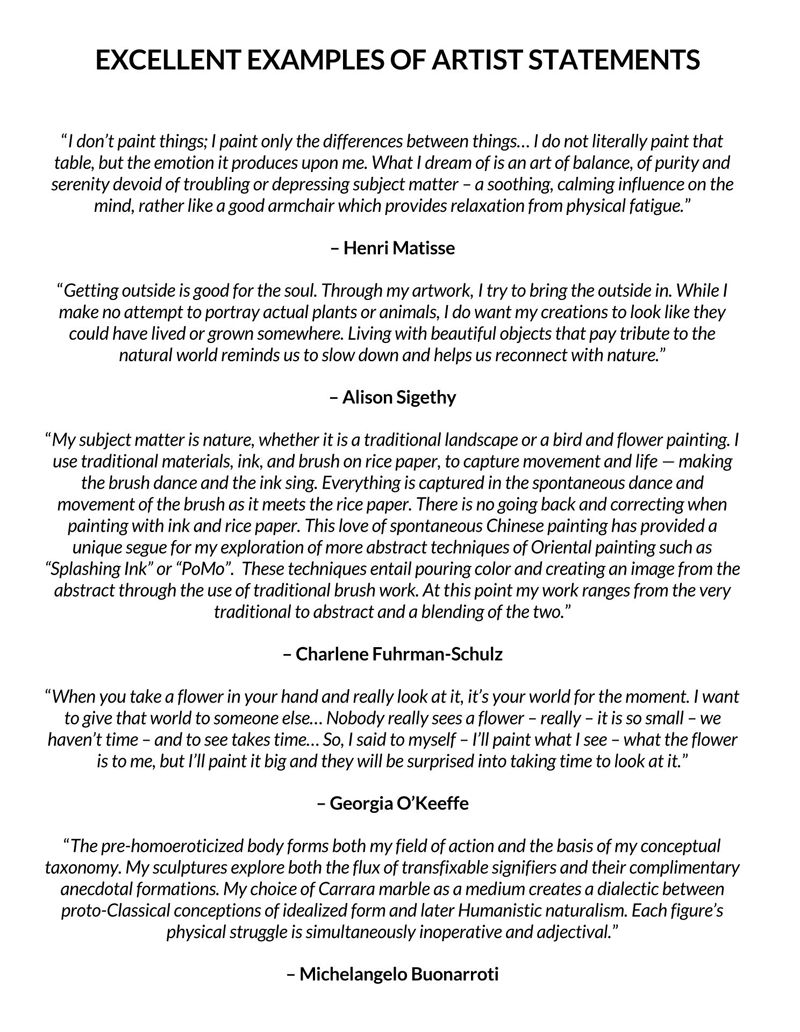
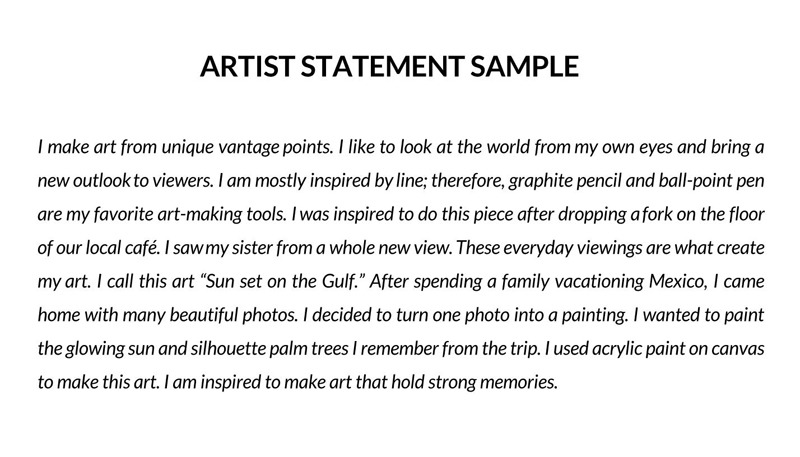
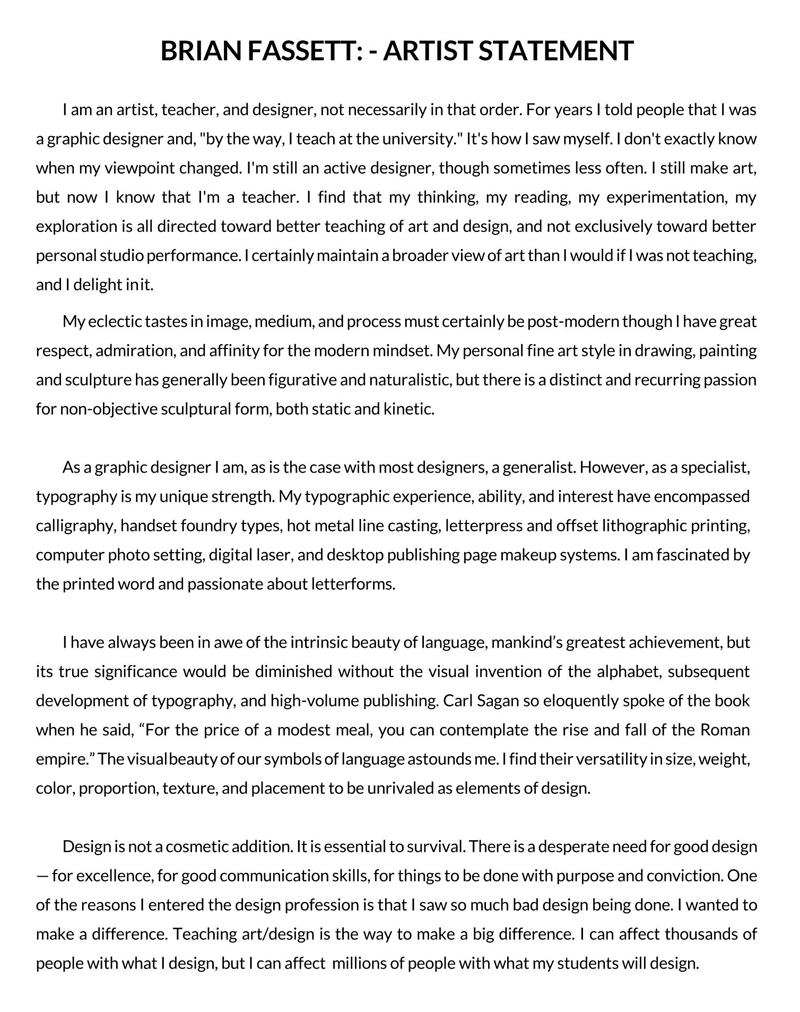
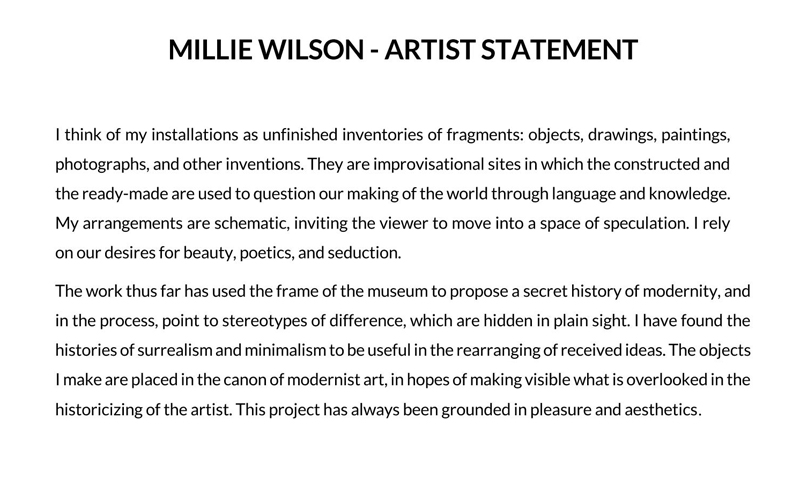
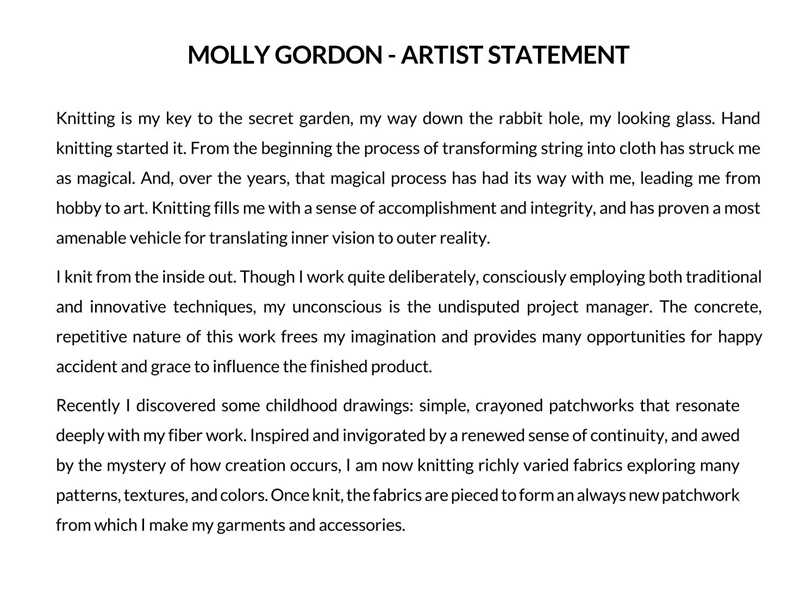
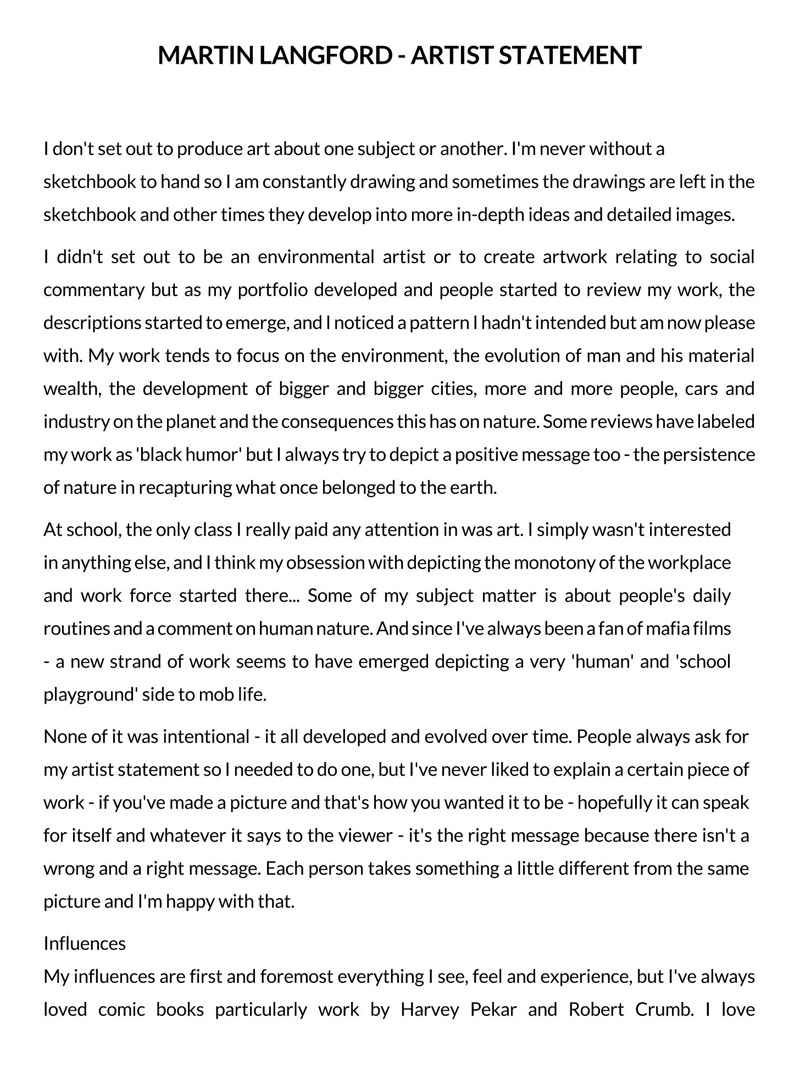
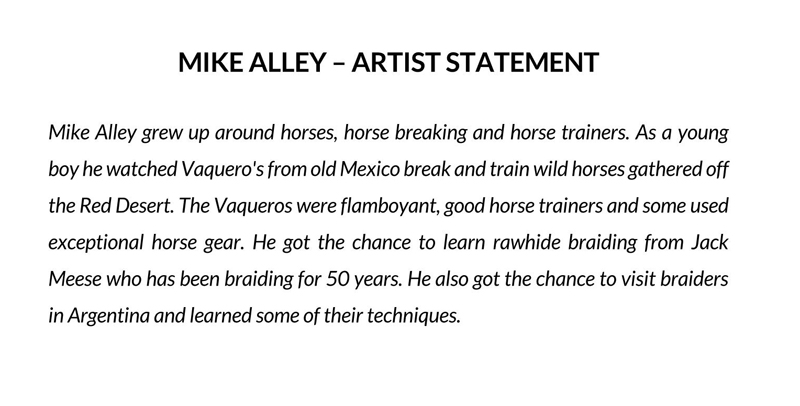
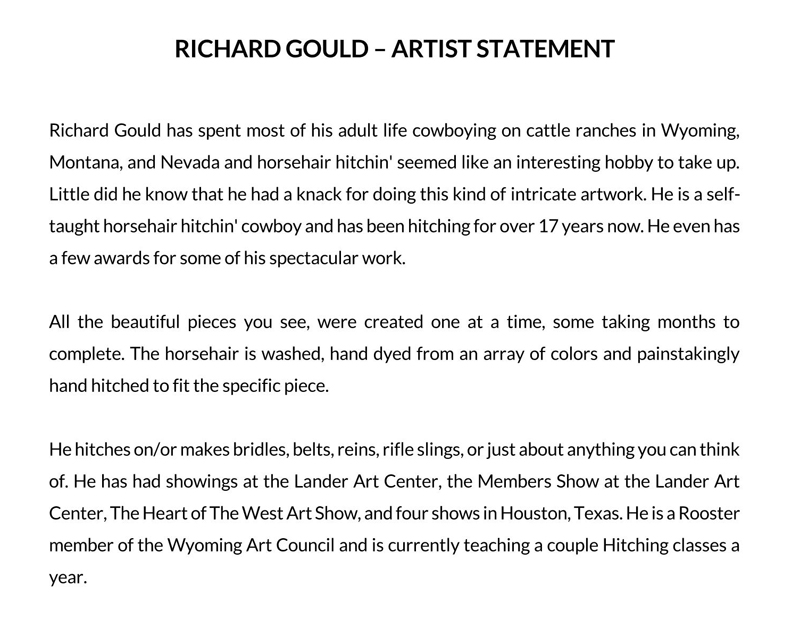
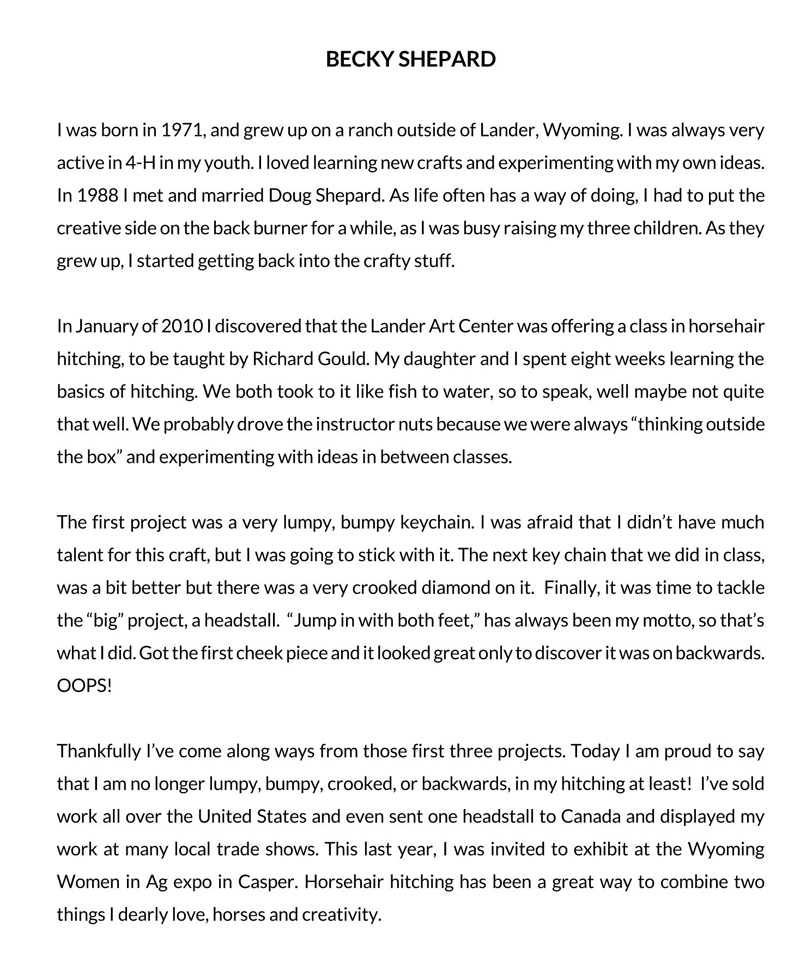
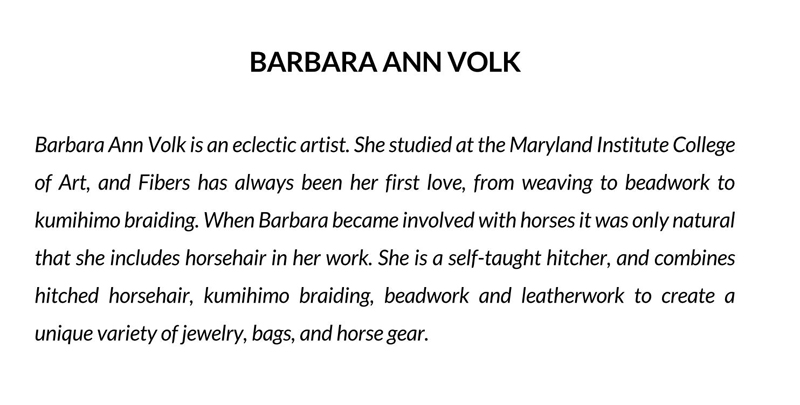
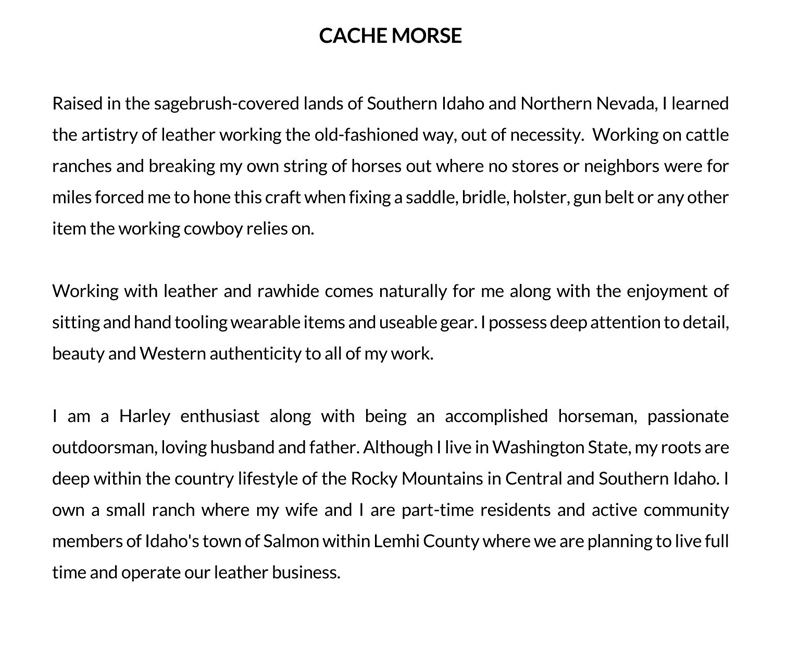
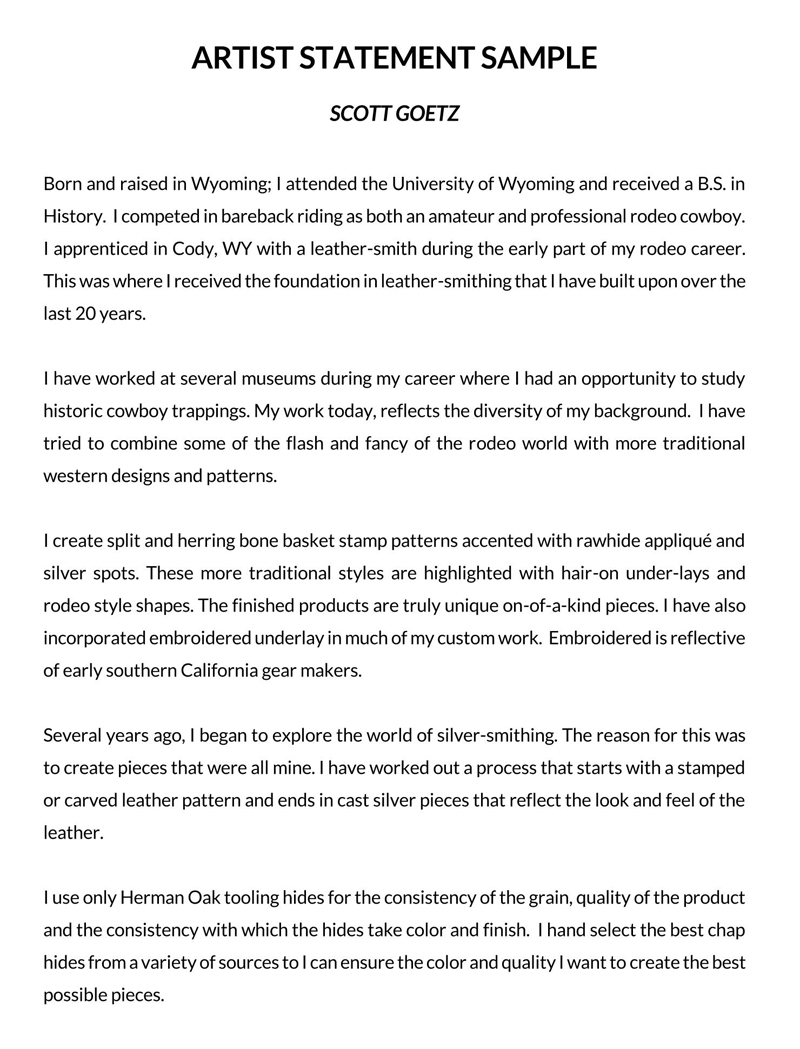
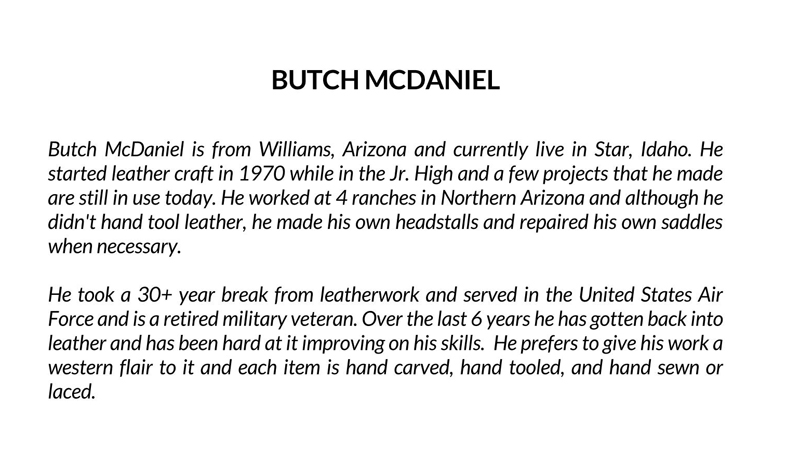
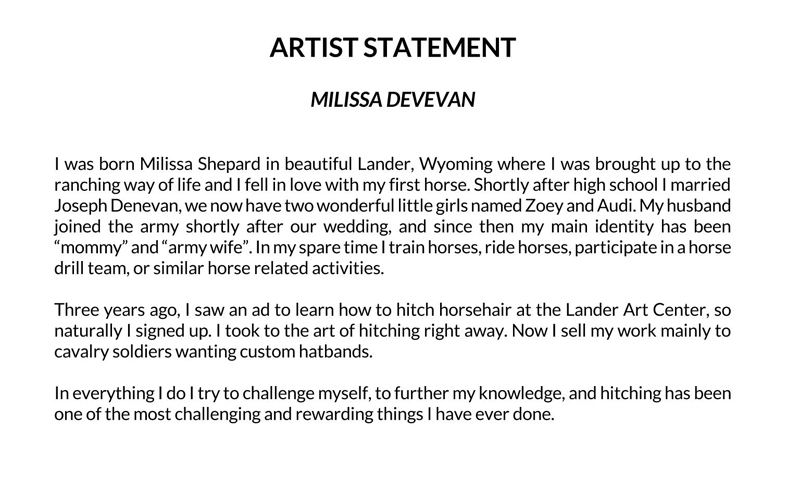
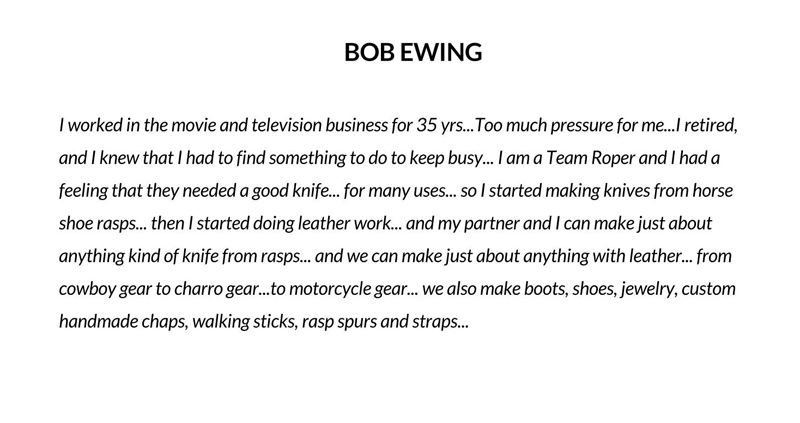
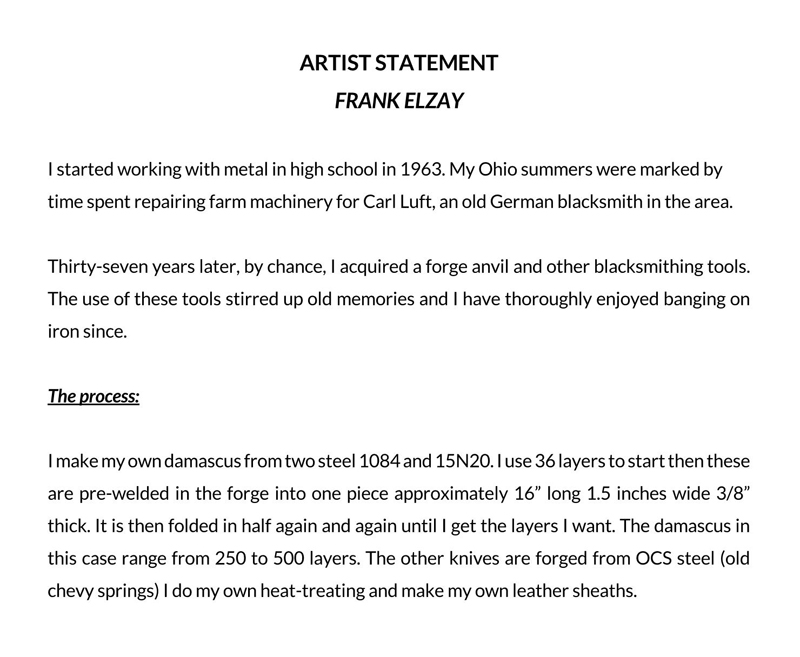
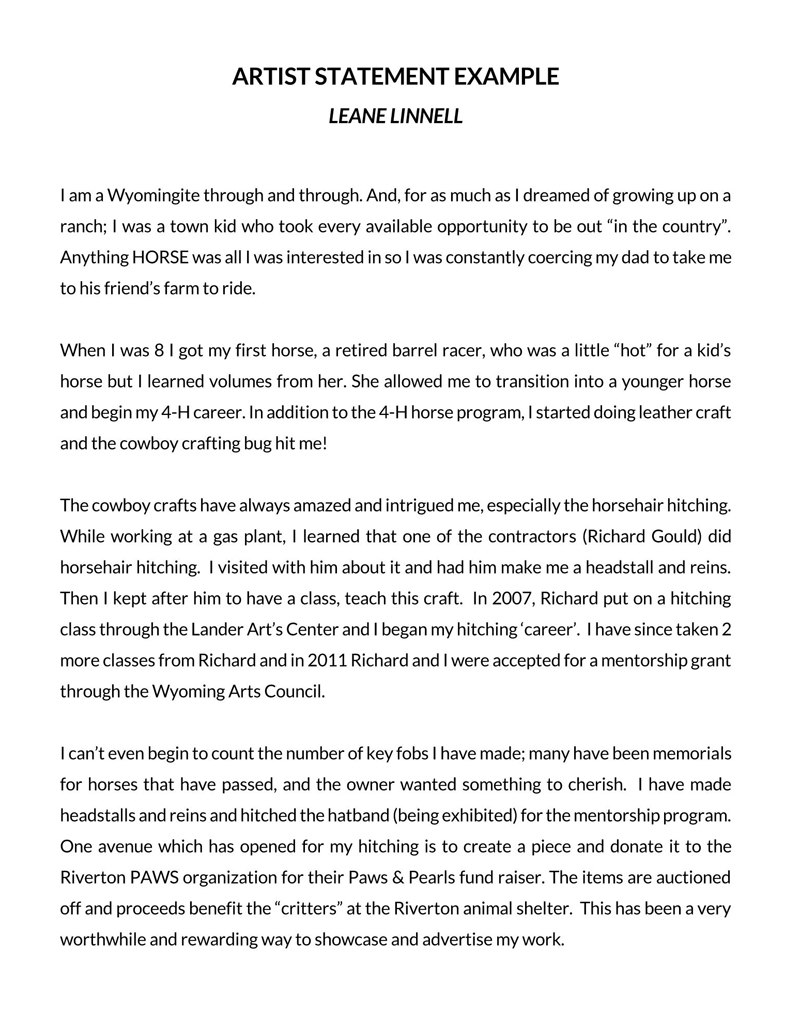
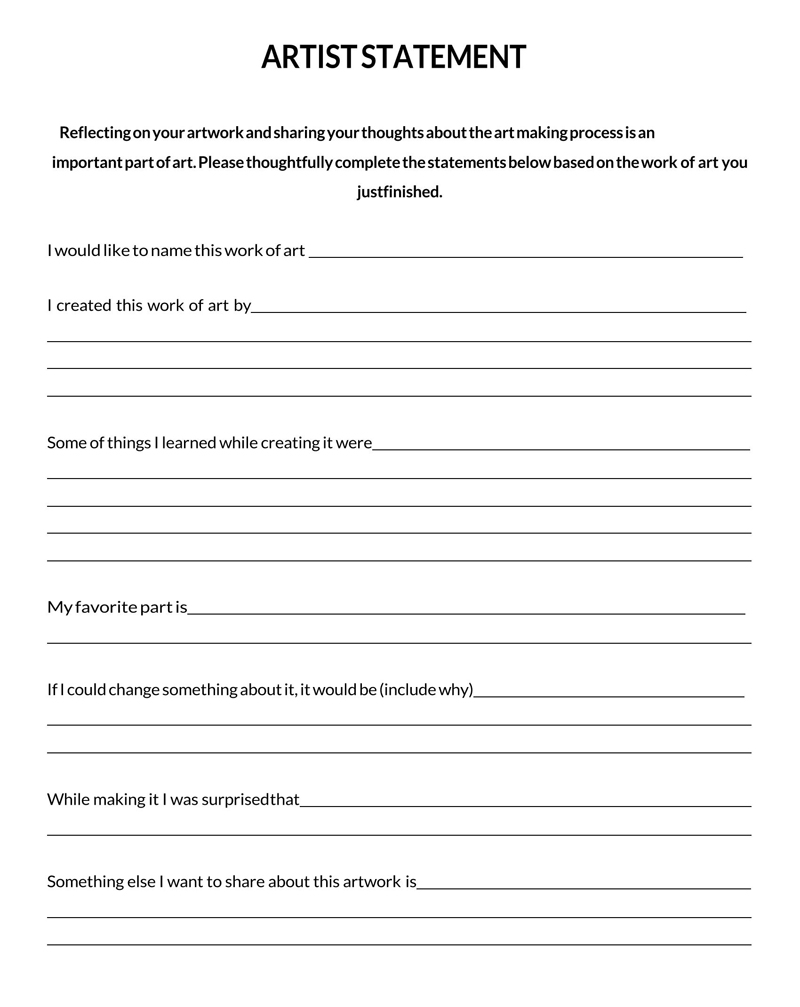
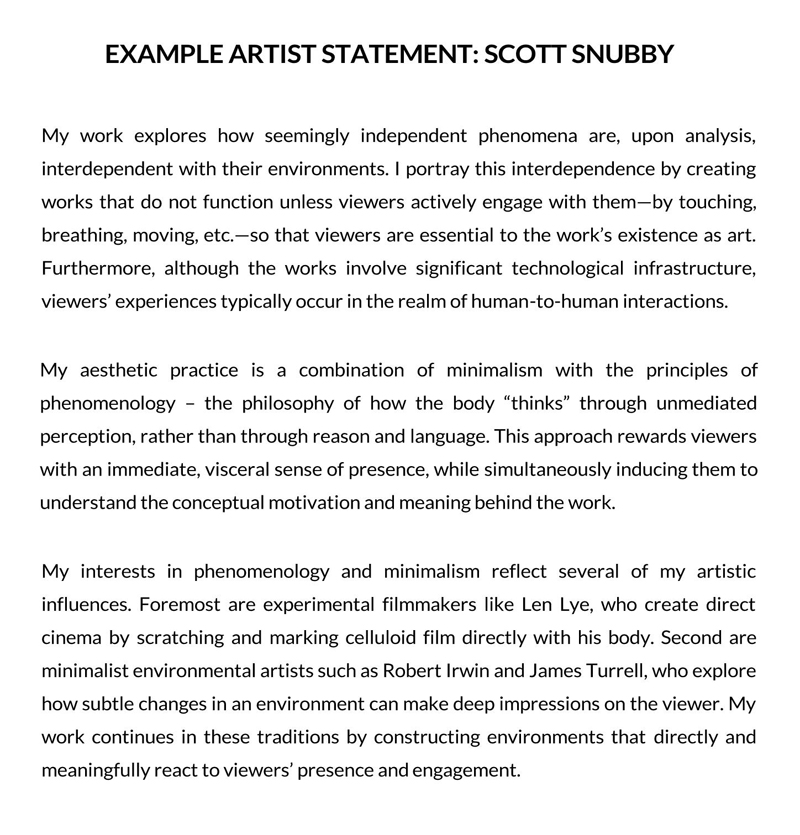
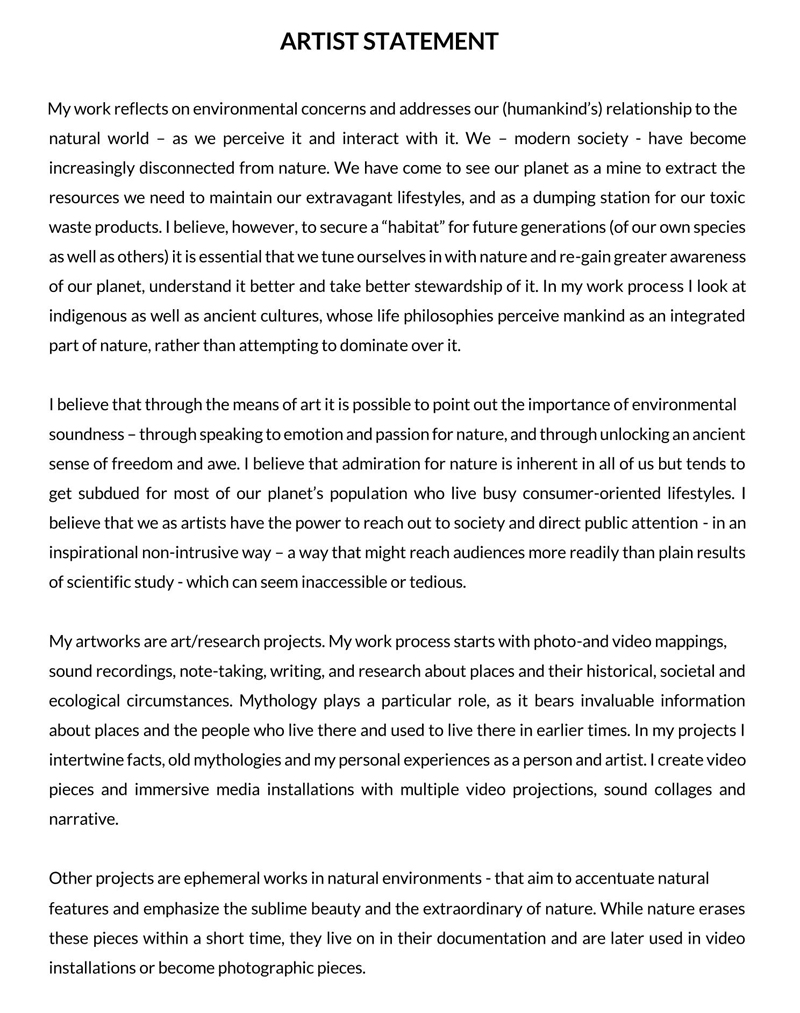
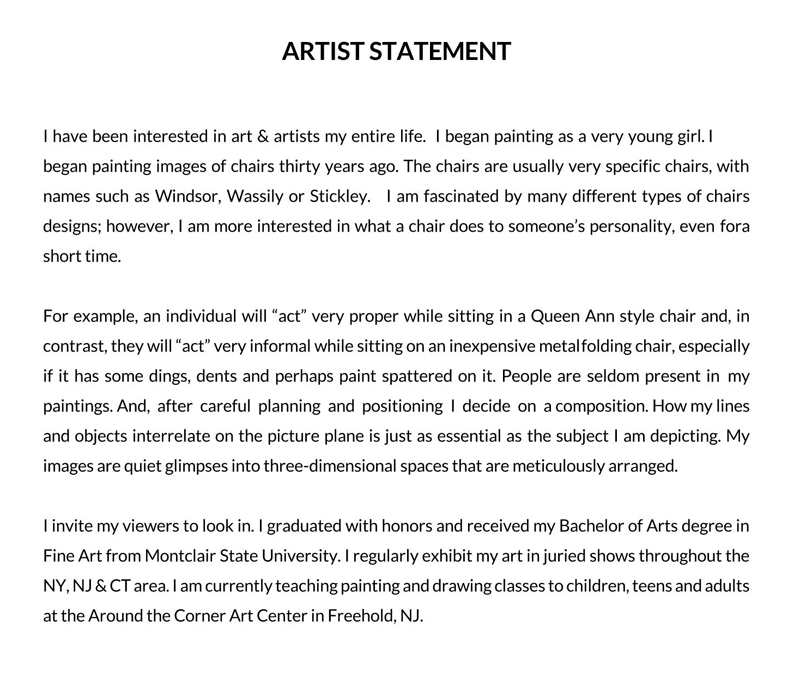
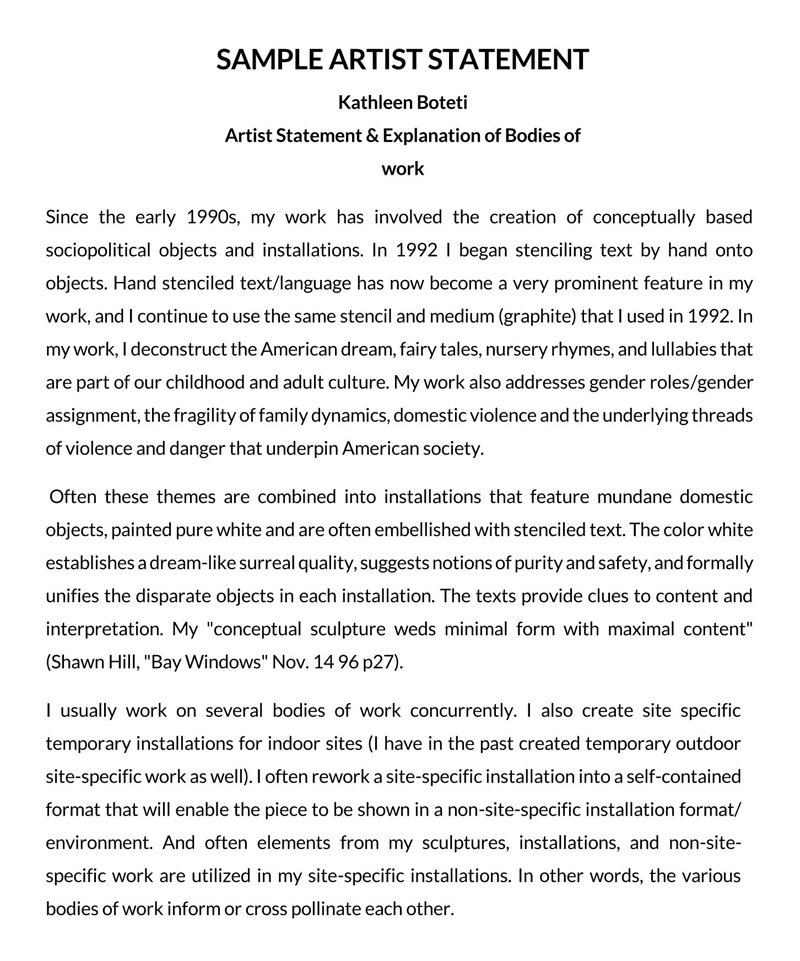
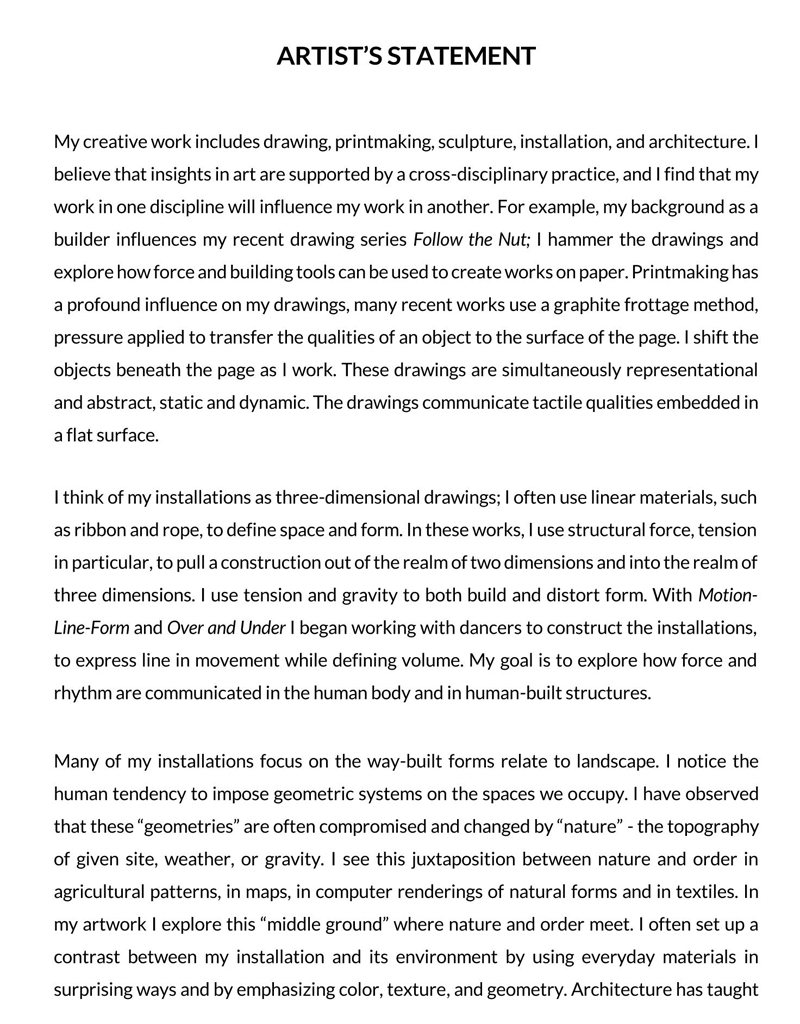
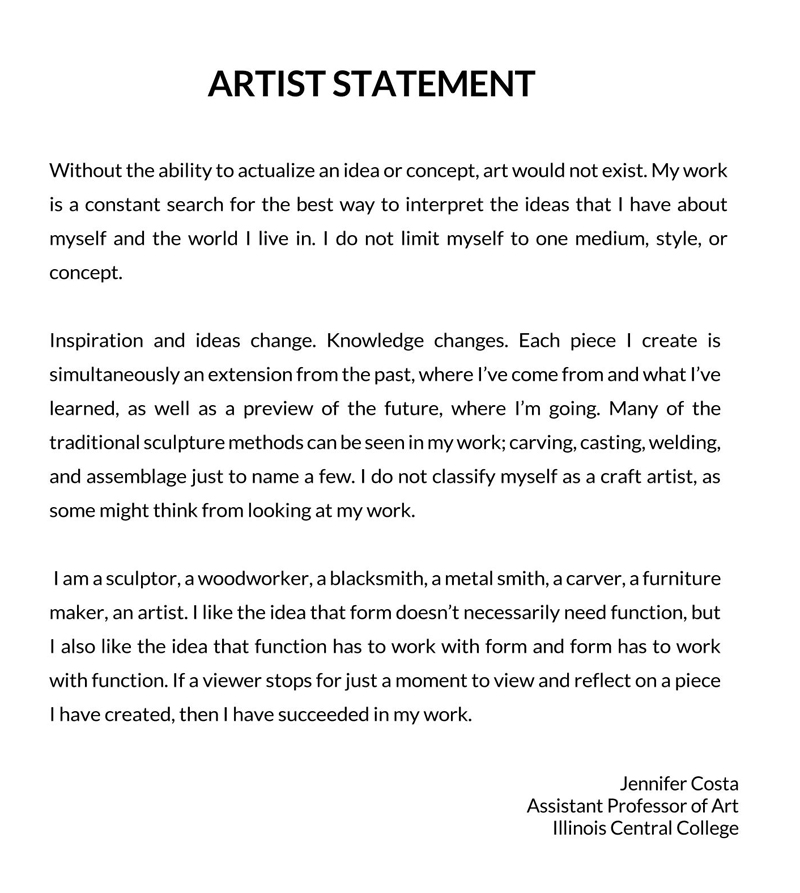
What an Artist Statement is Not?
When writing an artist statement, you should avoid incorporating the following elements.
- Technical and jargon that a limited group of people can understand only
- Prosy writing
- Flashy expressions and clichés praising the artwork
- Disclosures about the techniques and methods used to create the work
- Long explanations and strings of adjectives
- Childhood or family details unless they are significantly relevant to the artwork
- Stories about events in your life
The artist statement should highlight the mentioned details without assuming the role of other aspects outside its definition. It is therefore essential to declare that when writing an artist statement, it should not come off as.
- A short fiction
- An art history lecture
- A Manifesto
- A press release or opportunity praise oneself
- A self-psychoanalysis
- An outline of an artist’s career accomplishments
Purpose of Writing an Artist Statement
Artist statements have multiple benefits and thus are used to achieve different objectives. Firstly, it is a good engagement tool that clarifies an artist’s ideas to the audience and illustrates how they were incorporated in their work.
Artists can also submit artist statements when applying for funding, entry to art competitions and galleries/exhibitions, and graduate school.
Artist statements come in handy to assist reviewers when assessing one’s artwork. In addition, gallery dealers, curators, and the public can always use more insight into the work. This helps you, the artist, take control of your narrative.
Artwork enthusiasts want to know some background before buying a piece of work. An artist statement is a perfect way to spark and capture their interest in one’s work, leading to more purchases.
An artist statement is also used when creating a portfolio or a cover letter for yourself in the art industry, incredibly upcoming contemporary artists. The statement can also be uploaded on portfolio websites or social media platforms. This can reach a larger audience which helps grow one’s audience and brand.
In some cases, artists write a statement for reference in the future. For example, the statement can be consulted when the work is reviewed in a college or university, included in an art library, or when the artist’s work is taught in a lecture. It can also be used when someone else is writing a bio for an art program where an artist’s work is being used.
Artist Statement vs. Artist Bio
When an artist statement describes the artwork and its inspiration, a bio focuses on its journey as an artist. Therefore, a bio will primarily focus on the artist, while a statement will focus on the art. Therefore, a bio can be written in the third person as a third party can write it.
Unlike the statement,
an artist bio will outline notable events in the artist’s life, place of birth, base/location of operation, formal qualifications, accomplishments, apprenticeship programs you have participated in, and education.
Through this information, the bio tries to link the artist’s experiences with their involvement with art.
While a statement is used during applications, an artist bio is used to create your profile as an artist and can be added to interviews, articles, and exhibition catalogs. In addition, since a bio is the artist’s history, it is consistent throughout your career, unlike an artist statement that can be adjusted depending on the intended purpose or incorporate developmental changes in a piece of work.
Types of an Artist Statement
As an artist, one might require different types of artist statements depending on the situation. The following are the different types.
- Full-page statement: A full-page statement is the most common type. It will often entail the overall vision, context, artistic process, the relationship between the current work and other previous works, inspirations, intentions behind it, and how it fits with other contemporary art practices, methods, and history.
- Short statement: A short statement incorporates the details of a full-page statement but in a summarized manner. It can also be made for a specific project in which an artist is involved.
- Short project statement: A short project statement is limited to information about a specific project. A case in point is when presenting work.
- Bio: A bio outlines the highlights of an artist’s career and the life experiences that led them into an art career.
Basics of an Artist Statement
The artist statement should be long enough to give adequate information for the viewer to learn more about an artist’s work. Now, what do you include in an artist statement? The statement should highlight the how, what, and why of your work.
How
The how is answered by outlining the medium, materials, and methods used in creating the work. Some of the methods used to create art are acrylic, oil painting, photography. Examples of materials are canvas, wood, recycled materials, or metal. The how represents the artistic process.
What
The “what” is addressed by describing what an artist makes and the content (subject matter) of the work. Art made by artists are sculptures, paintings, non-narrative videos, murals, installations, abstract painting, etc. A brief depiction of the subject matter can go a long way in helping viewers interpret your work.
However, considering in most cases the subject matter will usually be obvious, there are two ways to engage with the audience in that regard. One can either not provide the subject matter and let the audience interpret it for themselves or indirectly describe the subject matter.
Why
The statement should also contain information about why the artist does this art. The why is an opportunity for the artist to stand out from other artists. This element discusses the influences behind the art and how it was manifested in work. Therefore, a relationship between the artist’s influences/inspirations and the work can be established. You can outline the symbols used in work and the reason (message) behind them.
Considerations Before Writing an Artist Statement
To write a captivating artist statement, it is best to prepare before proceeding to write. As much as practicing makes it good, you can perfect your statement by considering the following pre-writing considerations.
- Gather your artwork in one digital or physical space and look at it. It is essential to have your artworks in one place and carefully look at the commonalities and differences so that you can pick out a consistent subject matter and elements that stand out from each work. Having a holistic observation of your work helps draw the relationship between works included in the statement.
- List all the adjectives that best describe your work. Carefully view your work and come up with a list of adjectives that best describe your work. Avoid using artistic jargon. Use adjectives that appeal and are relatable to your audience. Visual and tonal descriptors are all acceptable.
- Record yourself describing your artwork to a friend, family member, or fellow artist. Creating a simple video of yourself talking about your work is a source rich in details that can be included in the statement. This is because the recording is not pre-scripted and therefore allows you to openly discuss pertinent details about the work in your own words.
- Think about the emotions and reactions you want your audience to come away with. Considering your work’s audience is an essential factor. Remember, an artist statement is meant to be engaging with the audience. Therefore, identify your audience and find ways to evoke emotions and reactions through the statement.
- Write a casual letter to your best friend about what you’ve been up to in the studio. To come up with details about the work in your own words, opt to write an introductory letter to a friend outlining the creative process you have been undertaking to create your work. You can then source details from the letter to write the statement.
- Jeopardy your practice. Think of the questions you intend to answer with the work and incorporate the answers as content for the statement.
How to Write an Artist Statement?
Once there is enough information to go into the artist’s statement, one needs to convey the information through the statement compellingly and seamlessly. The statement should be written in a clear, concise, and consistent. The following steps can be followed during the writing process.
Step 1: Opening of the passage
The statement should start with an overview of the artist and the work. Let the viewer know who you are, what your work is about, and the inspiration behind it. This can be achieved in a few, 3 to 4 sentences or one paragraph.
Step 2: Second paragraph
Next, the statement should outline the ideas, themes, and artistic methods and how they are presented in the work. This section contains the essential details about the work. Next, it should be curated to appeal to the audience by considering their preferred emotional tone and level in academics, analytics, humor, political, professional, and theoretical perception of your work. Finally, it should communicate what the artist is trying to say in their work.
Step 3: Final paragraph
Lastly, one should conclude the statement by restating the key points discussed precisely and concisely. A few sentences will be sufficient to give an adequate conclusion.
The statement should be written with a word processor to make it easier to make alterations when updating the document. Also, ensure to keep older copies for reference in case you need to talk or write about older works.
Do’s and Don’ts of an artist statement
To ensure you come up with a statement that best represents you, your work, and shapes the viewer’s perspective, consider incorporating the following do’s and don’ts.
Do’s
The following do’s can improve the quality and delivery of an artist’s statement.
- Write in 1st person: Write the statement in your words. Use the 1st person “I.” The 1st person is more personal and relatable to the audience.
- Use your voice: Try as much as possible using your (active) voice. This way, the statement feels more conversational – like you are speaking to the viewer. In addition, an active voice creates a connection with the viewer.
- Consider your audience: Always put the audience in consideration. Try to be relatable to them to avoid a situation where they feel alienated. The statement should feel like it is being addressed to them.
- Write in different versions: Write the statement in different versions and determine the version that best represents you and your work.
- Answer the right questions: Consider the questions that come to mind when a person interacts with your work. Then, prioritize the questions and attempt to answer them in the statement.
- Use accessible language: Use a native language that addresses the audience where the work is being viewed. This may sometimes necessitate the use of a translator, either online or a physical translator. Ensure the message is communicated as intended.
- Look at your art and read your statement aloud: Read it aloud and ask yourself if it represents you adequately, is compelling, and unique to you and your work.
- Work it into submission: After reading it aloud, identify errors and typos and edit accordingly for submission. The statement should be single-spaced, and a 10–12-point font is recommended. more minor than that, the statement might be illegible. Avoid using fancy fonts and formats.
- Shorter is better: The statement should be precise, and as a result, it does not have to be too long. Make it shorter by removing repetitive phrases and words. Compare repeated phrases and choose the better of the two concepts. The length and the structure of sentences should be adjusted accordingly depending on the complexity of the idea. Complex ideas take up long sentences.
Don’ts
Artists should avoid the following elements in their artist statements.
- Extreme binaries: The statement should not be strictly limited to one extreme binary. For example, it should not be too casual or too formal, light, or dark. Avoid leaning towards on extreme.
- Lazy clichés: Avoid using cliché words to describe the work or yourself. Remember, the objective of the statement is to make the artist and their work to be unique.
- International art English: Try avoiding the international art English often promoted through press releases, wall labels, and artists in the art world. It tends to be nonspecific, complicated, and exaggerated in nature.
- False range: Although the false range is generally acceptable, informed viewers will generally pick it out and can produce a negative impact on your work, especially if they are to give a review of your work. Avoid being everywhere; there is no fault in drawing inspiration from an artist’s singular work instead of their entire catalog.
- Theory: Do not include art theory in the statement unless it can be directly linked to your day-to-day studio practice or artistic/creative process.
When writing an artist statement, align it with the audience and purpose for which it is meant for. Different audiences will demand a different tone. The original statement should be created to act as a blueprint for all other future statements of the specific work. Before updating the statement, artists should review previous statements to remain within the idea behind the work.
Before submitting the statement, have other people like friends, mentors, and family go through it and provide feedback. This helps in analyzing the reception of the statement. Ask for brutally honest feedback if you want an excellent artist statement. Once reviewed, edit out all errors and incorporate suggestions made as seen fit. Remember, the statement is written for the audience, not the artist.
Frequently Asked Questions
There are several places an artist statement can be placed depending on preference and purpose. First, it can be placed in a binder at the gallery entrance together with the artist’s resume, list of works, and past reviews or articles about their work. Second, it is attached to the artist’s application for funding, competition, or exhibition entry. Third, it can be hung on the wall. Also, it can be included as part of a presentation, project report, or program for performance. Lastly, artists’ statements can be issued to any viewer who would benefit from its contents.




